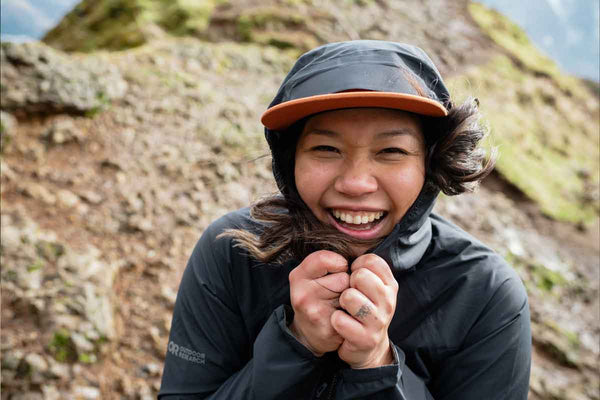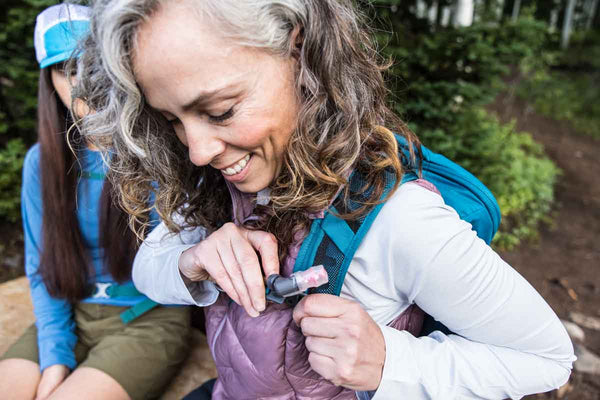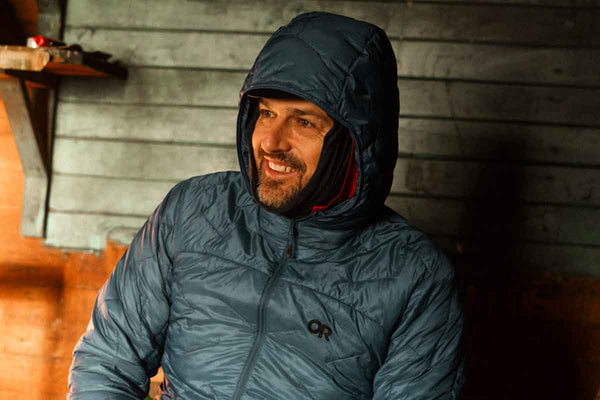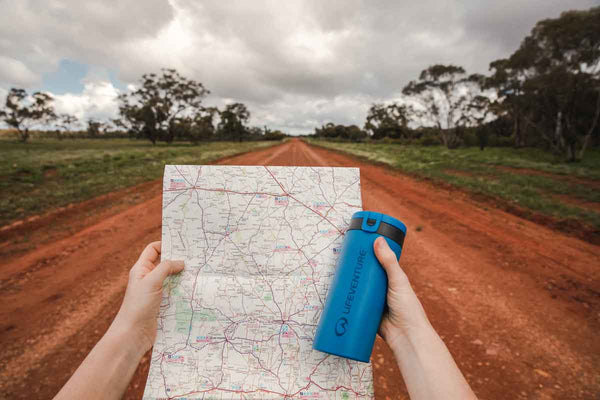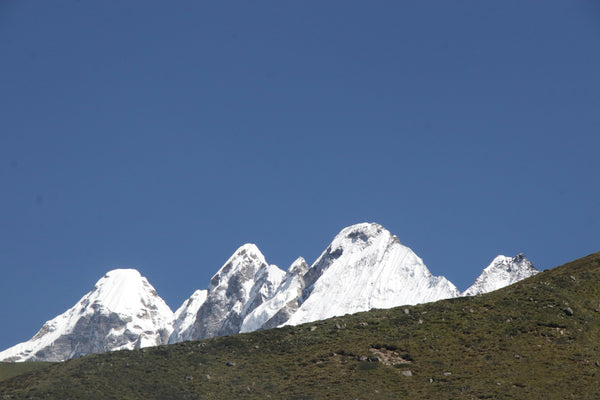
Scratching a Twitch: A Lollop in Langtang, Part II
by John Jamieson
Day 3: Sherpagoan (2563m) – Ghodatabela (3030m), Bird Count: 17
With 1000m of climbing the previous day there were a few aches and pains as we awoke. Any discomfort or fatigue was however waylaid when we opened the breakfast menu to find a selection straight from a Scotsman’s dream! With bread, potato, porridge and pancake options we fuelled up for the day's adventures. Striding out from the tea house, it wasn't long before a pair of azure blue birds streaked across the sky in front of us. Catching a brief glimpse through my binoculars I was able to note something akin to a Disney bluebird with a black eye mask like the Lone Ranger! The Verditer Flycatcher (Eumyias thallasina) was a beautiful start to the day but better was to come. Rounding the next bend, Galden pointed to the valley slopes below us where a troop of Gray Langurs (Semnopithecus schistaceus) were foraging and playing in the trees. With my wildlife sensors now on full alert I also spotted a small family of wild boar (Sus scrofa cristatus) rummaging in the undergrowth not far below. With the zoologist in me momentarily satisfied, it was an easy one hour walk to our morning tea stop.

Mani Wall with Ganchenpo (6387m) in the distance
The settlement of Rimche stood at the junction of the low route (more commonly used) and the high route that we had taken. Nursing our ginger tea we watched groups of weary trekkers trudge up the climb from the forested valley floor and were very pleased to have taken the more direct route the previous day. The trail after Rimche was but a gentle climb and within 15 minutes we came to the ramshackle village of Lama Hotel. Often the first stop on many itineraries, Lama Hotel appeared a little dingy and we were glad our first night experience was at Sherpagoan instead. Another pleasant hour’s amble up the valley through tall flowering forest led us to a delightful clearing by the river (cleverly named Riverside). Consisting of only a few buildings and a kitchen shed it made a beautiful spot for a leisurely lunch. With apple pancakes all round I watched White-capped Redstarts (Phoenicurus leucocephalus) frolicking in the river rapids as dad made notes on the mornings interesting shrubs and trees.
Two hours of gentle walking from Riverside saw the trees recede and before long we were above the treeline. As the valley widened out we scoured the high alpine slopes for signs of life. My pulse quickened when a sparkling rock of iridescent blue appeared to move and upon closer inspection the number one target on my to-see list revealed itself. The Himalayan Monal (Lophophorus impejanus) is not only Nepal’s National bird but also happens to be one of the most stunningly colourful birds you will ever see. With a skip in my step we made good time to Ghodatabela where we stayed for the night.
Day 4: Ghodatabela (3030m) – Langtang Village (3430m), Bird Count: 32
After a night ensconced in another cosy tea house called Hotel Tibet, we rose early to see the sun gradually illuminate the head of the valley and our ultimate destination. Breakfast proved eventful as we administered minor first aid to a Sherpa who had badly damaged his knee. The wider valley, lack of trees and proximity to the massive 6000m peaks gave day four a very different feeling to those at the start of the trek. From here in it was all about the mountains!

Landslide at site of Langtang Village
Now at over 3000m our itinerary allowed for a shorter day and an altitude gain of only 400m, which I was glad of as I started to feel the first effects of the thinning air. Meandering through scrubby grassland we passed numerous jingling donkey trains hauling loads of cement to aid the rebuilding efforts further up valley. With every step we grew closer to the base of the imposing mass of Langtang Lirung and after one and a half hours of gentle walking, we stopped for tea in its huge shadow. Nestled directly beneath the 7227m peak we revelled in the sense of perspective that only landscapes of such grandeur can evoke.
Our vantage point at Gompa also overlooked the sobering remnants of the landslide that had engulfed the village of Langtang. A village of over 400 people was no more and the vast dark grey scar upon the slopes above hinted at the immense volume of rock that had come careering down. The mood was pensive as our guide offered prayers before we made our way out across the landslide on the new trail. It took 45 minutes to negotiate the rocky climb before we came to the new village of Langtang sited 200m up valley from its previous location. A testament to the resilience of the local people, we found a bustling settlement of tea houses, bakeries and smiling faces eager for our custom. Arriving in time for lunch we settled into our aqua painted lodgings before exploring the village and surrounds in the afternoon. Come evening, I had a headache coming on and we retired early to bed hoping it would subside by morning.
Day 5: Langtang (3430m) – Kyanjin Gumba (3830m), Bird Count: 35
As we headed away from Langtang the next morning we came upon the first of many structures known as Mani Walls. Made of stone slabs engraved with Buddhist mantras, local people walk around them (in a clockwise direction) reciting the prayers as part of their nightly routine. After tying another Khada to one of the walls we investigated the intricate carvings before taking a slow walk up valley. With Kyanjin Gumba being the sole destination for most people on this leg of the trek it was the first time we came across significant numbers of other trekkers. Now I am as sociable the next man but is was not long before we bumped into a group that irritated and got my inner grumpy old man wound up!

The trail from Rimche to Bamboo
Insert rant: One such gaggle could be heard from miles away, their large speaker blasting out Eminem for everyone to ‘enjoy’. I am pretty sure most walkers did not envisage taking in the glorious mountain vistas with a rap score effing and jeffing in their ears. Quietly seething inside we slowed down and let them get ahead of us but it wasn't long before we caught them again, this time squatting behind a Mani wall relieving themselves! This disrespectful act really tested my British aversion to causing a fuss and I almost took them to task for it. Thankfully I was beaten to it by French lady who was naturally more adept at such a task. A guide is by no means essential on this trek but the very least you can do is be aware of the cultural structures and practices you may encounter. An educated trekker is a respectful trekker. Rant over.
Eager to get back to my happy place, we stopped at a tiny hut by the side of the track for a cup of tea. Being a relatively short day there was no rush to get going so we took our time to take in the mountain views. As we did, I saw the distinctive green silhouette of two Aarn packs sashaying into view. Pleasantly surprised to see the brand in such exotic climes, I walked over for a chat and found that they had purchased the bags from here at Trek & Travel a couple of months prior! The big bad world can be tiny sometimes!
Setting off again, we passed several clever hydro prayer wheels in small streams, spinning under the water's power. As the valley gradually widened we came to a beautiful Stupa that had been rebuilt after the earthquake. Rounding the next bend a small cluster of industrial looking buildings stood out as they straddled the track. As we got closer, we saw a shining silver pipe weaving is way down from the glacial lake above to we what later found to be the hydro electric plant that powered the upper part of the valley.
Crossing another sturdy suspension bridge we arrived at Kanjin Gumba after only four hours of walking for the day. The village was the largest we had stayed in and it took Galden a good 15 minutes to negotiate the maze of tea houses to find ours – Hotel Ghangchempo. The hotel was run by a friendly mother/daughter team that had relocated from Langtang village after the earthquake, having lost their house and husband/father. With my headache getting worse I was encouraged to have the garlic soup for lunch and duly complied with a side of Tibetan bread. My first experience of acute mountain sickness (AMS) had left me slightly unnerved but Galden did a quick assessment of my symptoms, finding little to worry about and prescribed paracetamol, lots of water and a good sleep.
Reassured, I proceeded to fend off dehydration, drinking volumes of water that later had me peeing like the veritable racing Yak! Stepping out later in the afternoon, we wandered around the village calling in to see paintings in the monastery and explored a little up valley. On our way back we were treated to a close up fly-past from the two species of Vulture in the valley. The barn door-like Himalayan Vulture (Gyps himalayensis) came first, soaring above blocking out dusk's fading light. The smaller, more streamlined Bearded Vulture (Gypaetus barbatus) followed, scouring the village for a bony meal.

Gray Langur
That evening at dinner we met a couple also suffering in the thin air. They'd marched up to Kanjin Gumba from Lama Hotel in one go, and the altitude gain of over 1000m in one day had led to symptoms much worse than mine. After resting for two days they were heading back down without exploring the mountains at all and I was very relieved that we had taken our time. Keen to get as much rest as possible before our summit push the next day, I went to bed early snug in my Earth Sea Sky Fleece Micro Pants, Exped Camp Slippers and Mont Zero Down Jacket!
Day 6: Kyan Gumba (3830m) – Kyanjin Ri (4383m) – Gompa (3300m), Bird Count 37
Rising from a restless sleep in the dry air, we set off early to attempt the climb to Kyanjin Ri. I felt a little better this morning and was so determined to get to the top that I left my binoculars in the room! This morning was about getting up and back anyway, no time for birds. With poles in hands we zig-zagged up from the village and step by step made good time up the steep slope. Galden had never seen us this focused and without avian distraction we surprised him with our climbing abilities! The cobalt tin roofs of the tea houses quickly receded to the distant valley floor below us we puffed our way uphill. After only one hour’s climbing we made it to the ridge and negotiated the small boulder field near the top. Flanked by multi-coloured prayer flags fluttering in the wind, the viewpoint at 4400m gave us a stunning 360° mountain-filled panorama that included the stunning Langtang Lirung and its glaciers. With the spot to ourselves we took our time to take it all in and get some intrepid summit photos.
After savouring the view for as long as possible it took only 30 minutes to meander our way back down the track to Kyan Gumba. Returning to our tea house we rested, packed and had an early lunch before saying goodbye to our gracious hosts. With a full afternoon in front of us and my nagging headache still causing discomfort, we decided to head off back down valley to spend our next night in more oxygen rich surroundings! Buoyed with the satisfaction of getting to our treks’ high point, we made good time retracing our steps back down the valley. Before long we reached Langtang Village and stopped for a refreshing ginger tea while Galden checked us out of the area with the park authorities. Traversing the rubble of the huge landslide again, we soon returned to the tiny settlement of Gumba where we shared the tea house with just two others for the evening.
Day 7 Gompa (3300m) - Bamboo (1970m), Bird Count 45
Rising early, we were met with low thundery rain clouds rolling up the valley. Fresh snow dusted the nearby peaks and we thanked our lucky stars that the previous day’s weather had been more favourable for our summit attempt. With time on our side we chose to have a leisurely breakfast and see if the rain abated. With no let-up in sight I was delighted to get out my new Arc’teryx Theta AR Jacket and Outdoor Research Foray Pants and test them in the wild! Feeling indestructible encased in Gore-Tex from head- to-toe, we headed off into the rain.
As it turns out, the wildlife seemed to take similar evasive action to avoid the downpours and as the rain relented we were treated to a much-delayed dawn chorus. This signalled the start of a bird bonanza and our vain attempt to log as many as possible led to a snail’s pace that tested the abundant patience of our guide and porter! Quickening our pace as hunger crept up on us, we stopped at a clearing in the forest called Woodlands for lunch. Watched closely by a silvery primate voyeur in the form of a Gray Langur, we devoured what was without doubt the best apple pancake in Langtang!
A pleasant amble to Lama Hotel soon changed into an altogether more challenging affair after Rimche as we took the lower route home. This section was by far the worst on our legs, and the knees really took a hammering. Even with two poles out Dad slowed up for the first time in the trip, in part because of the terrain but also due to immovable bovine obstacles that vied with us for track space on their way down to the village. An abundance of birds chirping in the ever-thickening forest was enough of a distraction to keep us motivated - the diminutive Fire Breasted Flower Pecker (Dicaeum ignipectus) proving Spot of the Day. After much twitching and cattle wrangling we made it to the village of Bamboo on the banks of the river, and settled into our most bijou (read shed-like) residence for the night.

An earthquake damaged bridge
Day 8 Bamboo 1970m - Syabrubesi (1500m) – Bistari Bistari! 8:00 – 14:00 Bird Count 56
On paper our last day of trekking looked to be an easy two hours back down to town. This however did not take in to account three things: 1) the potential to spot the elusive Red Panda, 2) an euphony of bird song to chase and 3) our desire for the trip not to end. Like a toddler avoiding bedtime we were determined delay the inevitable and squeeze as much enjoyment out of the day as possible. After descending from Bamboo to the river, the trail undulated gradually along its flanks. Slowly, slowly we continued down as a brilliant flash of scarlet red flared out from the canopy on the other side of the narrow valley. While neither big nor furry enough to be a prized panda glimpse, the beautiful Long Tailed Minivet (Pericrocotus ethologus) made a stunning consolation.
Passing scores of laden porters and weary trekkers lumbering up the trail towards us made us glad we had used the alternative high route on our first day. Much less travelled, with more expansive views and a more knee-friendly climb made it the perfect start to the trek. Using a different initial course also made for a more interesting trip as we returned by the lower route we had not yet walked.
Evidence of the earthquake was apparent upon leaving Bamboo, with sections of the track damaged and large rockslides regularly covering the old trail. One such landslip was particularly thought-provoking as it had claimed the life a young Israeli trekker and a make-shift memorial marked his final resting place. We spent much of the morning walking by ourselves with Galden going ahead and waiting for us to eventually catch up. At one rendezvous spot we arrived at a small homestead by the river to find the suspension bridge had been damaged in the quake and the suspension element was somewhat questionable. Certain there must be an alternative to negotiating what was now merely a floating fence, we waited to be guided to a safe, solid way across. That did not happen and instead we were instructed just to walk in the middle and not fall off. Simple. Just when I thought I had conquered the bouncy bridge phobia, a dangling twisted mess of wire presented itself! Gingerly I edged across the ‘structure’, concentrating more than I had done for the entire trip. With relief we all made it to the other side and celebrated with the obligatory 'we just crossed that' selfies!
Striding down valley the forest opened up as Syabrubesi came into view. Our final rest stop found us at the Happy Teahouse for more pancakes! Enquiring as to the origin of the name of the establishment our guide pointed out a familiar hemp like herb growing in abundance all around us, hinting that the friendly nature of our Nepali hosts may not have been entirely down to just their jovial personalities! Leaving the happy place behind it was only a short walk back into Syabrubesi where our trek finished.
Langtang Valley proved to be the perfect first taste of Nepal. The beauty, diversity and hospitality we received surpassed anything we could have hoped for. The ability to set our own pace with just us and a guide really made the trip. A slower pace allowed us to indulge our biological fascinations and it also allowed us to stay at different teahouses to the regular trekking itineraries. In a landscape of such immense scale as the Himalayas, it is easy to become hypnotised by peaks and glaciers but for me the joy of Langtang Valley was in the minutiae. The birds, the flowers, the time to disconnect. Get yourself to Langtang but take your time and see more than just the mountains.


